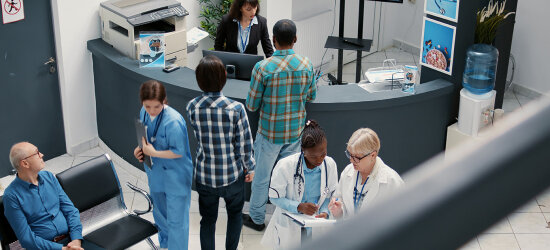We never know when we’ll need to go to A&E, either as a patient or with a friend or relative. We are therefore all potentially affected by long waiting times. The students had personally come across the lack of information while waiting in emergency rooms.
Their assignment was to use design methods to develop a solution. The student group got in touch with employees at an A&E unit in the county of Innlandet. Through workshops and interviews with both patients and health workers they gained a thorough knowledge of the problems faced by the unit in terms of patient triage and information, and of the opportunities which could be further investigated.
The students then designed various prototypes. In all, four user tests were carried out before all the pieces fell into place.

The picture shows a flow chart for a patient's progress at the emergency room.
Avoiding the waiting room
The result was Digivent [Digiwait], a digital solution for information exchange. The system consists of three components with a common core: an app (or rather an expansion of the Helse Norge-app), an info screen and an SMS service.
Digivent enables the patient – in real time – to keep an eye on any changes to the estimated waiting time, either on the info screen on site or on the app. This will enable patients to choose where they want to wait. This will reduce the stress associated with sitting in a waiting area with people afflicted by injuries, illness and insecurity.
The app will also have written information about typical injuries and preventive measures, and it can be used to give information about unforeseen circumstances affecting the waiting time, for example the arrival of an ambulance with someone requiring emergency treatment.
More and better information provides assurance
The objective of the students’ assignment was to design a prototype in order to visualise a concept which they felt would create value for the user.
The proposed service should result in the user feeling reassured and looked after. More and better information in a waiting room situation will create an understanding of the reason for waiting. This will give the user a better waiting room experience.
Brief facts about the project
Digivent: A digital service which makes the waiting time easier at A&E
By: Hanna Hernæs, Michelle Osnes, Ida Emilie Herfoss, Bachelor of interaction design, NTNU Gjøvik
Design disciplines: Interaction design, Service design, Design research
Recipient of the DOGA Award
This project has received the DOGA Award for Design and Architecture for its outstanding qualities and for showing how strategic use of design and architecture create important social, environmental and economic value.
These are three reasons why this is an exemplary project:
- Reduced stress
Many patients feel vulnerable while waiting in A&E. Digivent can make the waiting experience more predictable. Giving the user the option of waiting at home, in the car or somewhere else will reduce the feeling of unease, anxiety and stress.
- Better health care
A solution which provides a good flow of information between the user and healthcare personnel will contribute to better, more effective health care.
- Building on existing infrastructure
The proposed solution ‘Digivent’ is an expansion of the Helse Norge-app. If it were to be implemented, the service would be easily accessible in a portal which is familiar to most people and to which everyone has access.


